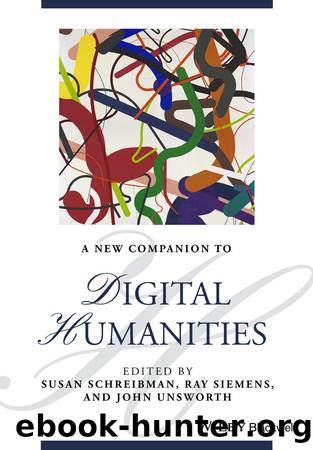A New Companion to Digital Humanities by unknow

Author:unknow
Language: eng
Format: epub
Publisher: Wiley
Published: 2015-12-28T00:00:00+00:00
Ubiquitous Text
Text may be less flashy and less glamorous than other forms of communication such as sound, image, and video, but it remains the dominant way that humans communicate, discover, and process information. It is estimated that every day some 200 billion emails are sent and some 5 billion Google search queries are performed â and they are nearly all text-based.4 The hundred hours of video uploaded to YouTube every minute would remain largely inaccessible were it not for text-based searches of the title, description, and other metadata. Even if we hesitate to join the poststructuralist theorists (like Kristeva, quoted above) in saying that everything is text, we can certainly agree that text is everywhere.
For humanities scholars and students working with texts as cultural artifacts, it is reassuring to recognize that people from every sector in our digital society are struggling with how to derive meaning from texts, from high-school students researching an essay topic to journalists combing through leaked security documents, or from companies measuring social media reaction to a product launch to historians studying diversity of immigration based on more than two centuries of trial proceedings.5 The particular texts, methodologies, assumptions, and objectives vary widely between different applications, of course, but fundamentally we are all trying to gain insights from the vast amount of text that surrounds us.
We are unrelentingly bombarded by text in our lives and we have access to unfathomable quantities of other texts.6 Yet for some, the problem is the opposite one: a dearth of readily accessible and reliable digital texts, whether because of legal reasons (like copyright or privacy), technical challenges (such as the difficulty of automatically recognizing characters in handwritten documents), or resource constraints that make it impractical to digitize everything (parish records scattered throughout the world, for instance). As a result, there is a significant inequality in the availability of digital texts, one that has a profound effect on the kinds of work that scholars are able to pursue.
When text is available there can be so much of it that we naturally seek ways of representing significant features of it more compactly and more efficiently, often through visualization. Visualizations are transformations of text that tend to reduce the amount of information presented, but in service of drawing attention to some significant aspect. For example, if you wanted to make an argument about the differences between the vocabulary used in mainstream commercials for toys targeted at girls compared with toys targeted at boys, you could simply compile examples from a sample set of about 60 advertisements and invite your reader to peruse the full texts. Or you could create word cloud visualizations for each gender, as Crystal Smith (2011) did (Figure 19.2).
Download
This site does not store any files on its server. We only index and link to content provided by other sites. Please contact the content providers to delete copyright contents if any and email us, we'll remove relevant links or contents immediately.
The Japanese by Christopher Harding(1084)
Watercolor With Me in the Forest by Dana Fox(752)
A Theory of Narrative Drawing by Simon Grennan(742)
The Story of the Scrolls by The Story of the Scrolls; the M(725)
Glittering Images: A Journey Through Art From Egypt to Star Wars by Camille Paglia(717)
Boris Johnson by Tom Bower(620)
This Is Modern Art by Kevin Coval(597)
The Art and Science of Drawing by Brent Eviston(588)
Frida Kahlo by Frida Kahlo & Hayden Herrera(584)
AP Art History by John B. Nici(574)
Banksy by Will Ellsworth-Jones(569)
War Paint by Woodhead Lindy(550)
Van Gogh by Gregory White Smith(547)
Draw More Furries by Jared Hodges(544)
About Looking by John Berger(543)
Scenes From a Revolution by Mark Harris(542)
Ecstasy by Eisner.;(535)
100 Greatest Country Artists by Hal Leonard Corp(523)
Young Rembrandt: A Biography by Onno Blom(512)
